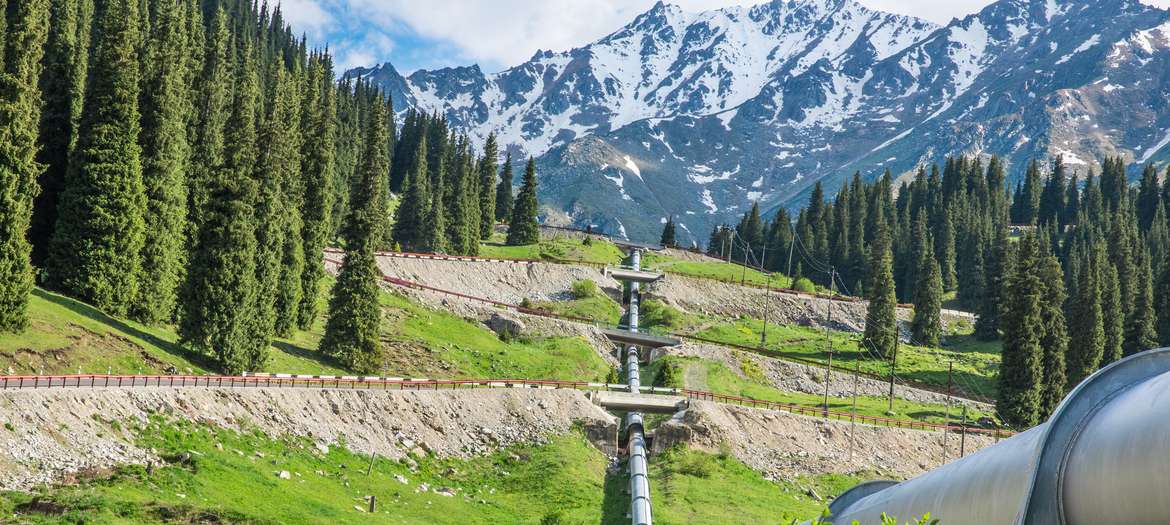SITUATION
Natural gas is transported in pipelines over many thousands of kilometers to destinations around the globe.
The new zero-emission mechanical seal from EagleBurgmann

Natural gas is transported in pipelines over many thousands of kilometers to destinations around the globe.
Even with technically sophisticated solutions such as dry gas seals, methane gas escapes.
The new zero-emission mechanical seal from EagleBurgmann prevents the emission of the greenhouse gas methane during natural gas extraction, transport and processing.
Natural gas is transported in pipelines over many thousands of kilometers to destinations around the globe, both overland and via the seabed. The flow of gas must be prevented from ebbing and drying up. Every now and again, giant compressors, like springs, with the power of about 100 car engines provide the necessary boost. But in the process, methane gas escapes. Until now, at least. The recently developed zero-emission mechanical seal, CobaDGS, from EagleBurgmann uses nitrogen to prevent these harmful emissions. The sealing innovation makes a sustainable contribution to curbing global warming.
Methane is the main component of natural gas and has a much greater greenhouse effect than carbon dioxide (CO2). Dr. Ferdinand Werdecker, Director of Engineering for Compressor Seals at EagleBurgmann predicts: If all the compressors in German pipelines no longer allowed the escape of methane emissions directly into the atmosphere and were instead sealed with CobaDGS, 15,000 tons of direct methane gas emissions could be avoided annually. This corresponds to 1.3 million tons when converted to carbon dioxide (CO2), which is equivalent to the annual CO2 emissions of around 600,000 private households. The new sealing technology could save four times this amount throughout Europe, and even fifty times the amount worldwide – equivalent to more than 63 million tons of CO2 per year.
How does EagleBurgmann’s sustainable sealing solution work? The compressor’s power is transmitted via a shaft to a blade wheel driving the flow of natural gas in the pipeline. The shaft sleeve through the compressor housing must be sealed. But this has always resulted in leakage – and even with technically sophisticated solutions such as dry gas seals, methane gas escapes.
Dry gas seals have a stationary and a rotating ring, whose contact faces almost touch. Less gas escapes if the gap is narrower, meaning the transport of gas is more cost-effective for the operator and the negative impact on the environment is less dramatic. The CobaDGS uses nitrogen to seal even this remaining gap, which is only two or three thousandths of a millimeter wide. The somewhat higher pressure of the “nitrogen barrier” prevents gas from flowing through the gap and escaping.
“We’ve advanced this basic principle to work at high operating pressures of up to 160 bar for the main seal. We use it for most of the compressors,” says Werdecker. A further benefit: Thanks to gas lubrication, the CobaDGS operates almost wear-free and, with proper maintenance, its service lifetime is virtually unlimited.

Between June 2017 and March 2019 the Hengli Group constructed an integrated refining and chemical complex in the Chinese harbor town Dalian where 20 million tons of crude oil are processed every year. EagleBurgmann advised the company Hengli concerning the selection of mechanical seals and supply systems for the whole plant and supplied more than 95 % of the components in use.

In Great Britain, a shortage in natural gas supply has severe consequences: Since the country switched from coal-fired to gas-fired power stations, a gas supply shortage makes households and industrial consumers not only vulnerable to failing heating and gas stoves, but also to power outages. Companies along the value and transportation chain of natural gas are therefore especially dependent on reliable equipment.

Things get hot in rotary kilns, very hot in fact. In the production of cement, for example, the thermometer measures more than 1,000 degrees Celsius. Sealing systems from EagleBurgmann, a company of the Freudenberg Group and EKK, make sustainable contributions to environmental protection, energy efficiency and process reliability under these "fiery" high-temperature conditions.

Our modern civilization is quite literally built upon cement. Today, building materials made from cement are used in buildings, roads, bridges, dams etc. Cement production is a heat-intensive process and causes thermal expansion in duct systems. To compensate this, Indian cement producer Ramco Cement needed fabric expansion joints with a diameter of several meters for two of their plants. On the basis of a close collaboration, EagleBurgmann was able to design components that increase the efficiency of the plant in the long run.

Frequent starts and stops are a severe test for gas-lubricated compressor seals. Installed in an Argentinean combined cycle power plant is an EagleBurgmann supply system that provides a continuous gas flow rate for the seals and adapts it to changing conditions. Since then, the operational reliability of the compressors has increased significantly.

Seals are a risk factor in the production of liquid crystals. If there is even the slightest contamination of the liquid crystals, this will later affect the image quality of the display. Read on to see which sealing solution Merck KGaA uses in paddle dryers for the production of liquid crystals.